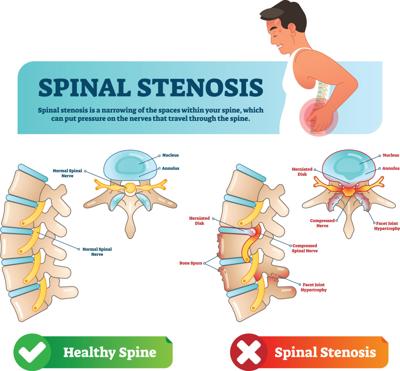
Spinal stenosis is a condition that's being seen in a growing population of those 50 or older. It's a back problem, but it can impact how people walk.
I’m enjoying the changing weather. These cool evenings and low-humidity days tell me fall is really here. It’s a wonderful time of year to enjoy walking and taking advantage of these days for the many outdoor activities that are still very doable around beautiful Delmarva.
Unfortunately, I have been hearing from an increasing number of people lately who are having problems getting up from a chair and for whom walking around isn’t very easy or comfortable.
It’s really not a surprise. When we pass the age of 50, a growing number of people are experiencing a problem with lumbar spinal stenosis (LSS). And no surprise either that a growing number of people are having this problem, because we have an aging population and the number of us older than 50 is estimated to climb by 18 million over the next decade. It all adds up to the likelihood that the cases of LSS will continue to increase.
If you’re not familiar with it and you’re one of the many of us over the age of 50, I’m sorry to say you may learn about LSS sometime soon. This common back problem can directly impact how you walk. The American Academy of Orthopaedic Surgery expects that by the end of this year more than 2.4 million Americans will be dealing with this condition.
As I so often tell you during our visits here in the Coastal Point, understanding the problem and getting the information you need can make an important difference for you or someone you know. That’s why we’re going to get down to basics, and look at LSS and what you might expect.
You have 33 bones or vertebrae that make up your spine. These interlacing bones have an opening. The fancy name for that opening is a foramen. These openings are important because they are all in a line and, together, they form the spinal canal, which is what surrounds and protects your spinal cord.
At the end of your spinal cord, that’s where you find a group of nerves called the cauda equina. These nerves have a very important job, because they’re the conduit for the sending and receiving of messages that come and go in your pelvic region and your legs.
LSS often results when your spinal canal has narrowed. That narrowing is putting pressure on your spinal nerves and interrupts the messages that have to pass back and forth. That’s why spinal stenosis can cause walking problems.
Now, here’s where it gets tricky. There are a number of issues that can result in LSS. After age 50, the wear and tear that we’ve inflicted on our spine can lead to a number of problems that cause LSS. Osteoarthritis is a common cause. Others can include herniated disks or injuries to the spine that can come from a fall, or ligament problems, as well as a number of spinal injuries that wind up involving the spinal canal.
What could you be experiencing that might mean you have LSS? If you have pain in your legs whenever you walk, this is one of the typical signs. Keep in mind that these symptoms can go up and down in intensity. At times, you might have severe pain, and at other times, it can be less severe. Some people will experience tingling in the lower back, buttocks and legs. Some people will also experience numbness or a feeling of weakness.
Here’s the part you should all know well by now: Don’t sit around wondering what could be happening and suffer. These symptoms should be your warning that you need to get to a doctor.
Take the usual steps before you go. Write down the information that gives your doctor a full picture and can be helpful in reaching a diagnosis. Tell your medical professional when you started experiencing your symptoms and how it has progressed. Has it gotten worse? Did have any kind of injury that could have damaged your back? You also need to tell your doctor about any other health problems that you have, and bring your list of medications and any supplements you take.
You can expect your doctor is going to ask you a number of questions to understand the full picture, and you may also have a number of tests. Your doctor wants to give you the best results, and LSS can be challenging to diagnose because there are many other conditions with similar symptoms.
Once you have been diagnosed, the likelihood is that your doctor may prescribe physical therapy, because physical therapy has been found to often be very effective in treating this painful problem. You should also know that your medical professional and your physical therapist will work together to create a plan that reflects your specific needs and considers your full health situation.
Your physical therapist is going to be creating a physical therapy program specifically for you that will be focused on reducing your pain and helping you return to your daily activities. The first step will be to examine you and talk with you about what you are experiencing, because this is a partnership. In fact, your physical therapist will look at a variety of factors to determine what will be best for your situation. It’s all about putting together a treatment program aimed at building your strength, flexibility and endurance, and the stability of your spine, along with all the factors that are integral to getting you functioning properly again.
Overall, it is probable your program will bring together a combination of manual therapy, exercises, stretching, strengthening and other techniques that will help you address the painful symptoms and work to prevent the condition from getting worse.
Don’t mess around with this or take chances. I can’t tell you too often that your quality of life can depend on your taking the right steps and getting the help you need.





